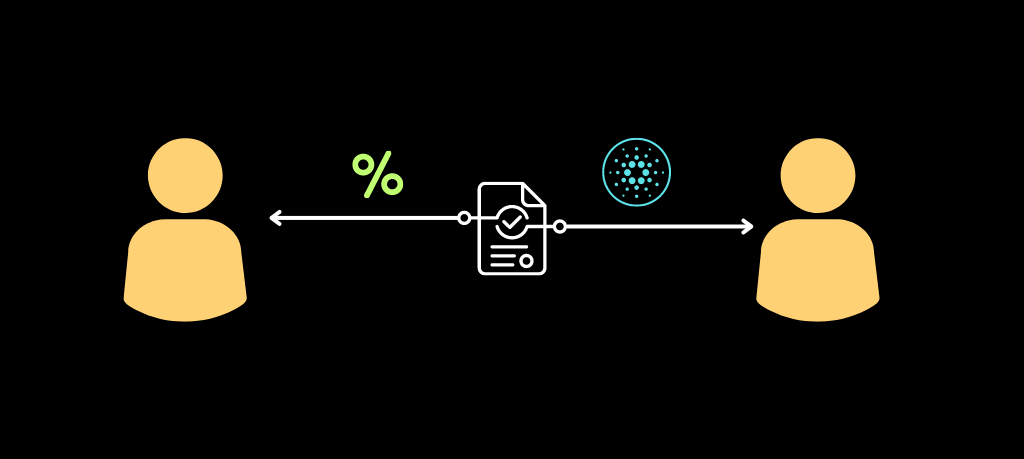
Introduction
Lending and borrowing are key elements of decentralized finance (DeFi), transforming traditional financial services by removing intermediaries. These services allow users to lend their crypto assets to earn interest or borrow assets by providing collateral. By facilitating these secure and transparent transactions through smart contracts, DeFi applications enhance liquidity and improve capital efficiency in ecosystems such as Cardano. Today we cover what DeFi lending and borrowing looks like, its landscape on Cardano, risks, and the future outlook.
What is DeFi Lending/Borrowing
In DeFi lending and borrowing, users can connect their wallet to a decentralized application to earn interest on their idle assets or borrow against their existing holdings without having to sell. The process is all carried out by code (smart contracts), which automatically execute and enforce pre-determined terms and conditions of the loans.
The most important thing for an application is that it is always able to honor withdrawals. The way that they do this is by requiring overcollateralization.
For example, in traditional finance, if I wanted to borrow $1,000, the bank would ask for a passport copy, address proof, income proof, etc. After receiving all this information, they would either approve or disapprove of the loan request.
In decentralized finance, such transactions are often anonymous and trustless. In this case, to ensure that I pay back the $1,000, I would have to deposit around > $1,200 worth of Crypto as collateral. Then, if the value of my collateral drops to a certain level, the application will automatically seize the collateral and sell it on the open market. The proceeds from that sale is then used to cover the $1,000 that was loaned to me.
Further mechanisms to ensure that the application is not losing money also exist, such as interest payments and insurance funds.
Lending/Borrowing on Cardano
The lending and borrowing landscape on Cardano exists in several forms. Users can borrow ADA, Stablecoins, Cardano Native Tokens (CNTs), NFTs, staking rights, voting rights, and more.
One fashion of doing so is peer-to-peer, where some users post offers for loans that they want and others can come in and accept terms.
For example, I have 1,000 USDM and I want to borrow 100 ADA for 1 year. I am willing to pay 10 ADA interest. I could go to a platform such as Lenfi (formerly AADA) and create a borrowing advertisement outlining my specifications. Then, lenders can browse a list of advertisements with varying token amounts, durations, and interest rates, and select the one that is best suited to their needs. This is a rather trivial process and the landscape thereafter evolved.
The second iteration is known as peer-to-pool lending, where all lenders aggregate their assets into a pool and all borrowers can go to that pool of assets and select how much they want to borrow. Parameters such as required collateral, collateral type (e.g. ADA or USDM), interest rate, and duration are all set by the pool itself based on the available liquidity. The benefits of this model are that borrowers can receive loans instantaneously as they do not have to find a direct counterparty. Similarly, lenders do not have to manually adjust the attractiveness of their offers as it is taken care of by the pool itself and all rewards are prorated.
Furthermore, Cardano's architecture allows for stake to be borrowed and lent without transferring the spending rights of the ADA. This means that while the borrower cannot spend your ADA, they can use the borrowed stake to participate in governance votes or engage in Initial Stake Pool Offerings (ISPOs).
Benefits
There are several advantages of lending and borrowing specifically on Cardano:
• The blockchain’s high assurance code, decentralization, and 100% uptime create an ideal environment for financial assets.
• Transactions are *deterministic, ensuring predictability in fees (*transactions produce the same result every time they are executed, regardless of who, where, and when the transaction is executed).
• User continues to earn staking rewards even when their ADA is used as collateral.
• Strong governance model allows for continuous evolution and improvement.
Risks
Industry-wide:
• Smart contracts vulnerabilities can lead to exploits and loss of funds.
• Market volatility and rapid price changes can cause liquidations.
• Low liquidity (not enough market buyers/sellers) when trying to liquidate can cause bad debt for the system.
• Changes in regulations could impact the legality of DeFi.
• Some projects may claim decentralization when in reality, they have a backdoor to steal user funds.
• Dynamic interest rates can make it difficult to plan ahead.
Cardano specific:
• Applications need to track the prices of assets in real time to know when a position needs to be liquidated. They achieve this through oracles. Oracle infrastructure on Cardano is still inadequate.
Future Outlook
The future of lending and borrowing on Cardano looks bright. Charles Hoskinson once said in an interview that it takes around 7 years for a programming language to reach full functionality and push boundaries. Cardano’s Plutus is only 3 years into that journey and already pushing boundaries. The strong foundations and elaborate governance model additionally ensure that the chain will be able to adapt (socially, technologically, and to abide with regulations).
What excites me the most about the future of lending and borrowing are the introduction of identity layers and real-world assets (houses, securities, and commodities) that will eliminate the need for overcollateralization and broaden the scope and utility of existing infrastructure. These innovations promise a dynamic and exciting future for lending and borrowing on Cardano.
